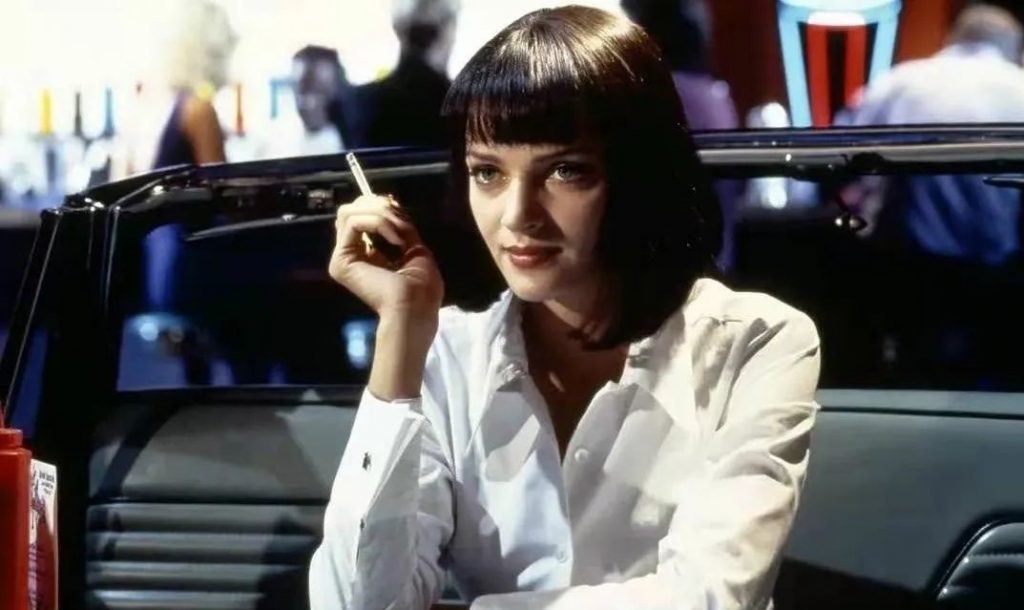Pulp Fiction: Postmodern Rebellion and Return

Quentin Tarantino uses the title “Pulp Fiction” (1994) to suggest the splicing of popular culture in the film, and relies on a non-linear narrative, stylized violence and noir themes to give it a distinctive personal label. The audiovisual language of “Pulp Fiction” is a continuation of what has always been the style of director Quentin’s work, and can be called the pinnacle of his work, disrupting and reuniting the narrative structure of the three stories, but unexpectedly without any sense of dissonance. He brings the film’s dark humor, full of uncertainty and chance, to the audience through his chic use of color and camera language. The success of this film announced that postmodern cinema finally became a powerful trend in cinema at the end of the 20th century, and “Pulp Fiction” became a masterpiece of postmodern cinema aesthetics, embodying the narrative style of postmodern cinema, which is of typical significance.

1.Narrative Structure
01 Segmented independent narrative
In 1994, the three-part structure seems to have become more popular, with “Pulp Fiction” and “A Rainstorm Is Coming” both using it as the backbone of their narrative power. Apart from the film’s prologue and end credits, the three central stories are “Vincent Wei and Marsellus’ Wife,” “The Gold Watch,” and “Bonnie’s Situation. “These are the three heart-wrenching stories. These three stories stand alone in the film, but within this novel overall structure, each is told in a clear and organized manner. The three stories do not seem necessarily connected, but rely on Vincent’s presence to connect the three stories. At the same time, however, the stories are disrupted, presenting us with disjointed but intersecting and closely related passages, and this is where the director’s ingenuity comes in. Quentin is obviously not satisfied with the traditional narrative, he will break the single chain of spatio-temporal narrative, relying on splitting and collage sorting, constructing a new narrative mode, while mobilizing the audience’s rich imagination to fill the chain of stories, so as to get a clear story, the film is through the three-part structure, its intention is richer penetrating and shocking. Quentin Tarantino deals with these three seemingly independent stories not by simply turning them upside down and misplacing them, but by breaking each story into many pieces and then rearranging and combining these pieces so as to disperse them into the other stories. As in the first story, the film proceeds to a stop halfway through when Vincent and Jules are grabbing back the money box to kill someone. In the third story, this part reappears, thus linking the stories together in their entirety, which creates the confusion of Vincent coming back from the dead that appears in the second story. In the different stories, time and space are constantly shifting, and each story has its own protagonist, while the protagonist in this story is often a supporting character in another story or in another time and space, leaving the ambiguity of his own story in advance while developing the plot for the other stories.

02 Circular Narrative Structure
The beginning of the film “restaurant robbery” is both the prologue and the end of the story. At the beginning of the film, the White Rabbit and the Pumpkin are planning a robbery in the restaurant, along with a robbery, officially opened the prologue of the film; at the end of the film, Jules and Vincent are eating in the restaurant, behind them, the White Rabbit and the Pumpkin are raising their pistols, this scene not only reconnects with the beginning of the film, but also lets us know that the characters in the story are in the same time and space. From the beginning to the end, and thus reconnected, it seems to be a circle, which then constitutes a circular narrative. It is through this circular narrative structure of connecting the beginning and the end that the director not only changes the audience’s habitual psychology of watching the film and adds suspense to the film, but also suggests that the violence never ends, and that a new beginning is birthed in the story that seems to end. For example, Jules’ comprehension of the Bible is split into several episodes inserted into the film. In the first story, Jules recites a passage of the Bible before killing someone; at the end of the film, when the White Rabbit and the Pumpkin rob the customers in the restaurant, Jules recites the Bible again, which not only echoes the film’s circular structure narrative, but also suggests that violence can be ended, and the most important thing is your choice. Each segment of the film seems too simple to be true, but they are so interconnected that we can’t cut any of them out of the story. The story begins and ends in the restaurant, the beginning is the end and the end is the beginning.
03 Splicing techniques used
The language of post-modernist cinema is characterized by a rebellious spirit and a number of formal elements, such as collage, random insertion of quotations and photographs, film “parody”, advertising, journalism, MTV and other subversive forms of expression. The artists of post-modernist cinema use simple yet creative ways to collage another post-modern image world that is different from the real life. Pulp Fiction” makes extensive use of elements from American history and culture and other films. Quentin Tarantino replicates these classic scenes and then uses his own unique techniques to give them a new and modern narrative approach. Vincent and Mia dance in the restaurant, a lot of use of the history of American dance and music in the history of the jungle boogie, swing dance and other humorous and witty dance, country, punk film music; White Rabbit and Pumpkin in the restaurant robbery plot parody Sam Peckinpah’s classic Western “Sunset Yellow Sand”; Jules always recite a paragraph of the Bible before killing, parody of the film “Night of the Hunter” in Vincent’s rescue of Mia by drawing a needle in her chest is a parody of the film One Hundred Years of Solitude; Jules’ fluffy curly hair, the parody of Marilyn Monroe’s classic shots and Mia’s tight shirts and bell-bottoms all exude the flavor of America’s past.

2. Characteristics of the film’s characters
01 Character Features
The characters are also a special feature of the movie “Pulp Fiction”. The many characters in the movie are not designed according to the inherent role model, but seek a kind of expression with more meaning beyond their identity. First, the characters’ appearances are very distinctive. When Vincent goes to Masha’s house to look for Mia, Mia meets Vincent for the first time through the monitor, and Vincent through his voice, and Mia’s image is not fully revealed in the film until the next shot when they go out to dinner together. In the second story “gold watch”, Butch came back to get the gold watch and was walking on the road Marsha met, this unintentional encounter seems a bit nonsensical, but is the director’s clever design without a trace, but also because of this encounter to have the two grocery store after the story, the story of the gold watch also came to a successful conclusion. Second, the identity of the characters is not the traditional sense of the image. In the general violence of the film like Butch role if defied the previous agreement, will be destroyed for breaking the rules of the game, but in this film, Butch not only killed Vincent and saved Marsha’s life, mastering the initiative of life, and the gangster Marsha, although higher status, but can not control their own destiny, not only by Butch car injuries, but also in chasing Butch into a After being raped by a pair of gay men after chasing Butch into a grocery store, the characters at the core of the power are instead unable to control their own destiny.
02 Atypical killer image
The characters in the film carry out acts of violence without clear intentions and purposes, the plot is absurd and bizarre, without value and meaning. For example, when Jules helps Marsellus deal with the traitor, the whole atmosphere is relaxed and harmonious, without any suspenseful and thrilling atmosphere to create. Vincent also does not show a killer’s ruthlessness and brutality. However, the events took a sharp turn in an inadvertent manner. Jules suddenly shoots the man sitting on the couch when the crowd does not resist, before executing the others. This sudden narrative set-up brings a powerful shock and impact, everything is quick, sudden and untraceable. Quentin’s rebellion against tradition is shown through the subversion and dislocation of the characters, as people in post-modern society are rich in material goods and pleasure, but full of emptiness and boredom inside, with nowhere to release.

3. Language “funny”
01 Language characteristics of the film
In addition to presenting a novel vision in the narrative romp and characters, the film “Pulp Fiction” is also unique in its design of verbal lines. Many of the scenes in Quentin’s film are written with large lines, which is a major design preference in Quentin’s handling of the camera, to drive the narrative forward with the use of large lines. The characters in the film talk about everything, and are not fixed on the particulars of their identity, rich and varied and humorous. Some people question Quentin’s use of language design, but these lines are not designed to be useless, but rather designed by Quentin to better convey certain intentions and suspense, which makes his film style more unique and distinctive.
02 Funny language in images
In most movies, killers are supposed to be cold, brutal, and low on imagery, but in this movie, Vincent and Jules as killers clearly break out of the confines of previous killer images with rich verbal expressions. The linguistic largeness of Vincent and Jules is still evident when dealing with the traitor, with Jules chattering away at the betrayer after entering the room and even reciting a passage from the Bible before killing him. The same goes for Butch’s recollection of the gold watch, which his father’s comrade brings back to him and then gushes to him about how hard it was to come by and how it is a legacy of hope. In Quentin’s film, the art of language loses its original heavy, profound expression, but is worth playing with and deconstructing, not needing to be able to elaborate and narrate, and the title of the film “Pulp Fiction” also has a deliberate intention to boast of vulgarity.
